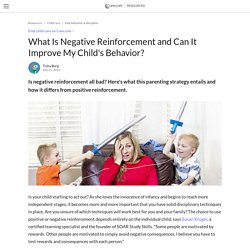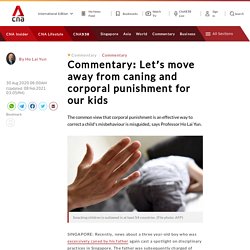

When you use reinforcement, you are increasing your actions, and when you use punishment, you are decreasing your behaviour. Punishment aims to reduce a response/action by administering aversive stimuli after the behaviour has occurred. Punishment can be either positive or negative, and reinforcement can be either positive or negative. Positive and negative reinforcers also increase the probability of a behavioural response. Punishers of any kind (positive or negative) reduce the likelihood of a behavioural response.
While psychologists advocate for positive reinforcement to promote positive habits, punishment may be effective as long as it does not damage the child's relationship with their parents. It helps the child recognise negative habits that should not be replicated and instead focus on positive behaviours. As a result, communication between parents and children is crucial, as teens are prone to asking questions.
As a result, communication between parents and children is critical, as teenagers often doubt their parents' motivations for their behaviour.
Introduction to Parenting through Reinforcement and Punishment. Skinner’s Operant Conditioning: Rewards & Punishments. The Use of Reinforcement and Punishment in Shaping a Child's Behavior. What is Reinforcement? Using Reinforcement at Home. Example of Reinforcement. What is Negative Reinforcement? What Is Negative Reinforcement And Can It Improve My Child's Behavior? Is your child starting to act out?

As she loses the innocence of infancy and begins to reach more independent stages, it becomes more and more important that you have solid disciplinary techniques in place. Are you unsure of which techniques will work best for you and your family? The choice to use positive or negative reinforcement depends entirely on the individual child, says Susan Kruger, a certified learning specialist and the founder of SOAR Study Skills. Example Application. Examples of Negative Reinforcers. What is Positive Reinforcement? Teens May Learn Best with Positive Reinforcement.
A new study finds that adolescents focus on rewards and are less able to learn to avoid punishment or consider the consequences of alternative actions.

University College-London investigators compared how adolescents and adults learn to make choices based on the available information. Investigators tracked the way in which 18 volunteers aged 12-17 and 20 volunteers aged 18-32 completed tasks in which they had to choose between abstract symbols. Each symbol was consistently associated with a fixed chance of a reward, punishment, or no outcome. Positive reinforcement is the one parenting trick everybody needs to know. At the start of the school year, Lonnie Starling was struggling with her eight-year-old son’s behaviour.

Another kid at school was being mean to him, and he was acting out at home by throwing tantrums, pushing, shoving and kicking. The Calgary mom remembered that using positive reinforcement—that is, focusing on the positive things he was doing, rather than constantly correcting his behaviour—had been effective to influence his actions when he was a toddler, so she got into the habit of praising him again. “When he does something good, we kind of go overboard.
We make a huge deal of it—if he’s helpful with things around the house, when he shovels the walk,” explains Starling. “His sister was upset and he brought her a stuffie. Positive Reinforcement - Tips for teaching and parenting. What is punishment? Using Punishment at home. Example of Punishment. How to discipline kids: New research shows what works. Getting small kids to behave can be a delicate science for parents.

Some worry about being too harsh; others are left exasperated by children who seem out of control. Many try to avoid yelling or spanking, and even time-outs are seen as too strict in some parenting circles. Popular Media Examples of Positive and Negative Punishment. How Punishing Kids Affects them as Adults. Youtube. Let’s move away from caning and corporal punishment for our kids. SINGAPORE: Recently, news about a three year-old boy who was excessively caned by his father again cast a spotlight on disciplinary practices in Singapore.

The father was subsequently charged of ill-treating a child by causing him unnecessary physical pain. Parents who use corporal punishment rarely set out with the intention to injure their children. However, a handful inadvertently cross the line when they are unable to control their emotions and actions. Last year, the Ministry of Social and Family Development investigated 660 cases of physical abuse in Singapore, which accounts for 60 per cent of all child abuse investigations.
Learning: Negative Reinforcement vs. Punishment. Pictorial Summary of Reinforcement and Punishment. Considerations.